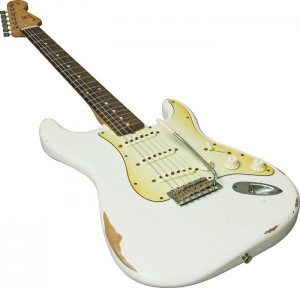![]()
![]() I found a great article today about the guys (John Page and Vince Cunetto) who built the first Fender Custom Shop relics back in the ’90’s and some of the techniques they use. Here are some interesting points;
I found a great article today about the guys (John Page and Vince Cunetto) who built the first Fender Custom Shop relics back in the ’90’s and some of the techniques they use. Here are some interesting points;
 Cunetto has spent countless hours doing R&D to find the right techniques.
Cunetto has spent countless hours doing R&D to find the right techniques.
To make the finger-wear marks on the fret board, he uses a architect’s powered drafting eraser. A few select screwdrivers and metal tools put chips in the guitar’s paint and dings in the wood.
“Every guy has his own little toolbox,†Cunetto says. “It’s like two painters using different brushes for the same thing.â€
The colorful finishes on the guitars are done with old-school lacquers. Page says he always uses nitrocellulose instead of modern polyurethane. He says nitro is “more spiritual†to him.
To accelerate the aging of the finish, you speed up the cycles of hot and cold the instrument would naturally go through. Cunetto keeps freezers in the shop, and after a few rounds of cooling and warming, the nitrocellulose lacquer begins to disintegrate. The effect is a beautiful spider web of tiny checkered cracks in the finish that make a new guitar look like it’s 50 years old.
But there’s more to making a relic than screwdrivers, ovens, erasers and sandpaper. It has as much to do with art as it does with science.
“It’s not just about making it look beat-up,†says Page. “The thing I always admired about Vince is that he aged it in the right way, in the right wear patterns. If this was a country player or a blues player, what specific parts of the neck would be more worn? Where would the chips be?â€
Cunetto says he tells his aging apprentices to dream up a back story for every guitar they work on, and to apply that story to the instrument. Every guitar ends up with its own personality, its own emotional resonance.
“Was this guy a country player? He’s going to have a lot of wear in the first position on the neck,†Cunetto says. “There’s probably a burn mark between the pegs from where he always sticks his cigarette. And he’s going to have a lot of buckle wear, because he’s wearing a big rodeo buckle.â€
The full article can be read here
 “I turned around and actually saw the van come through the window of the store,†Pittillo said. “It was slow motion.â€
“I turned around and actually saw the van come through the window of the store,†Pittillo said. “It was slow motion.â€